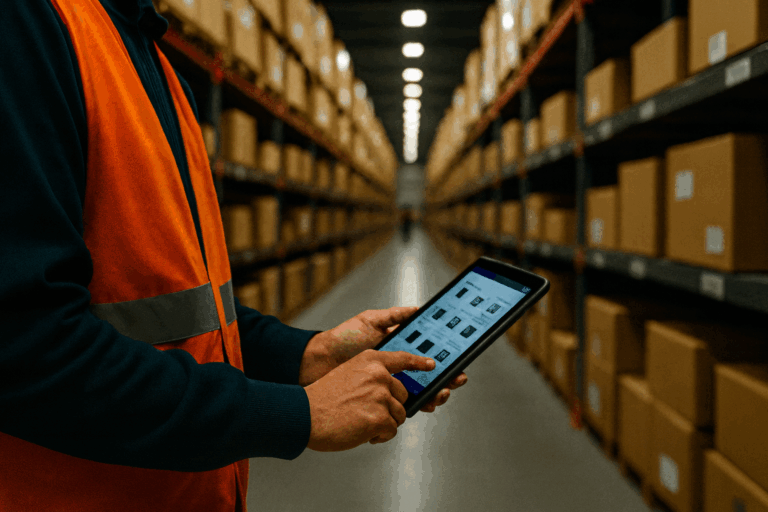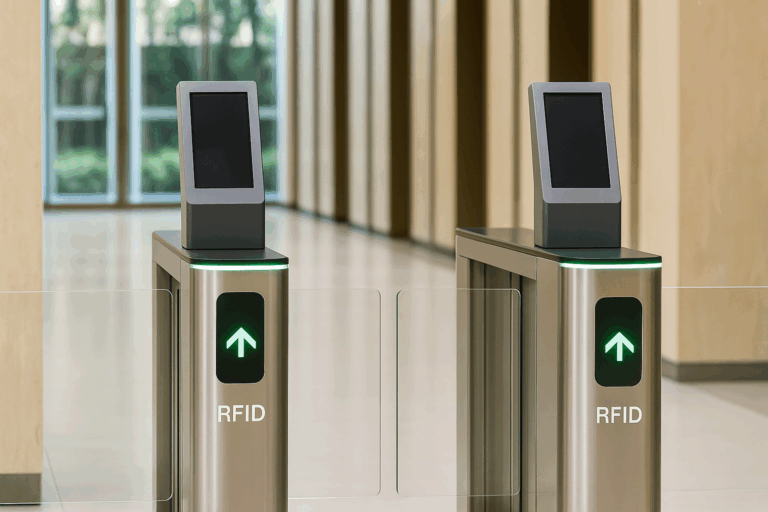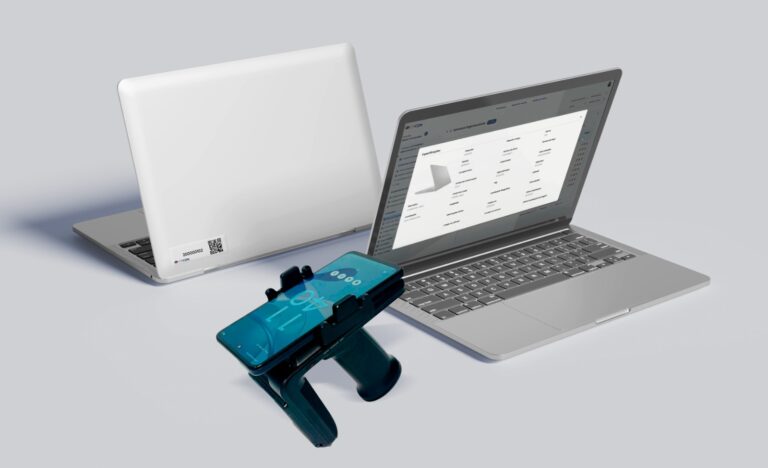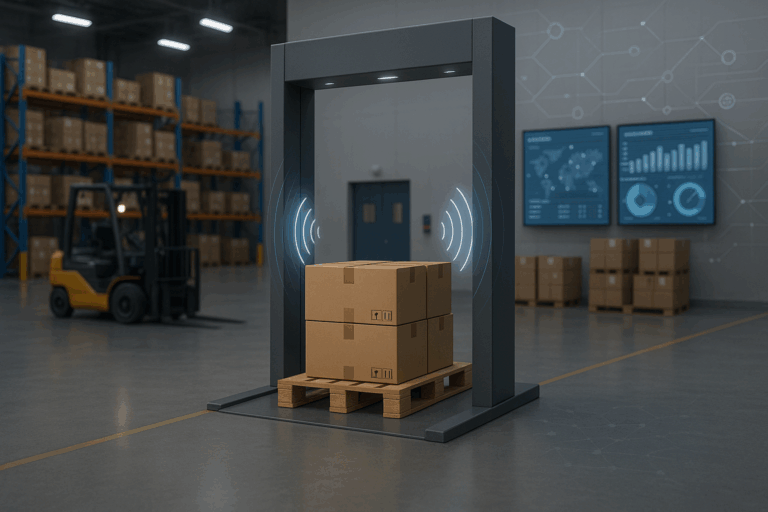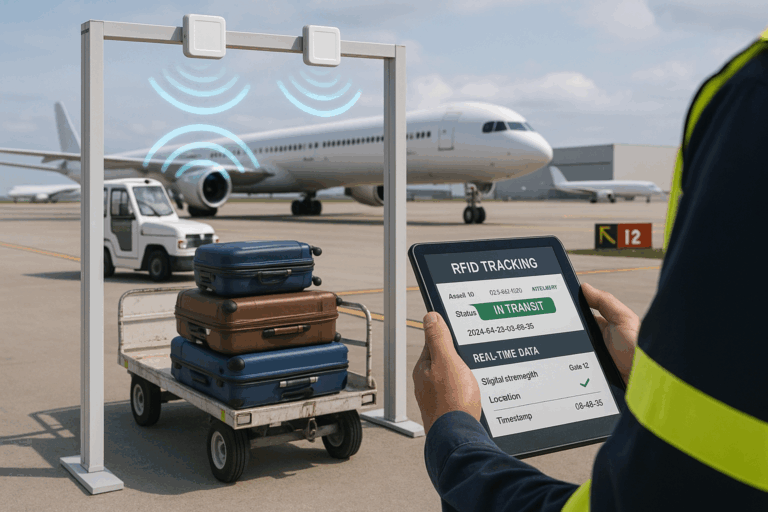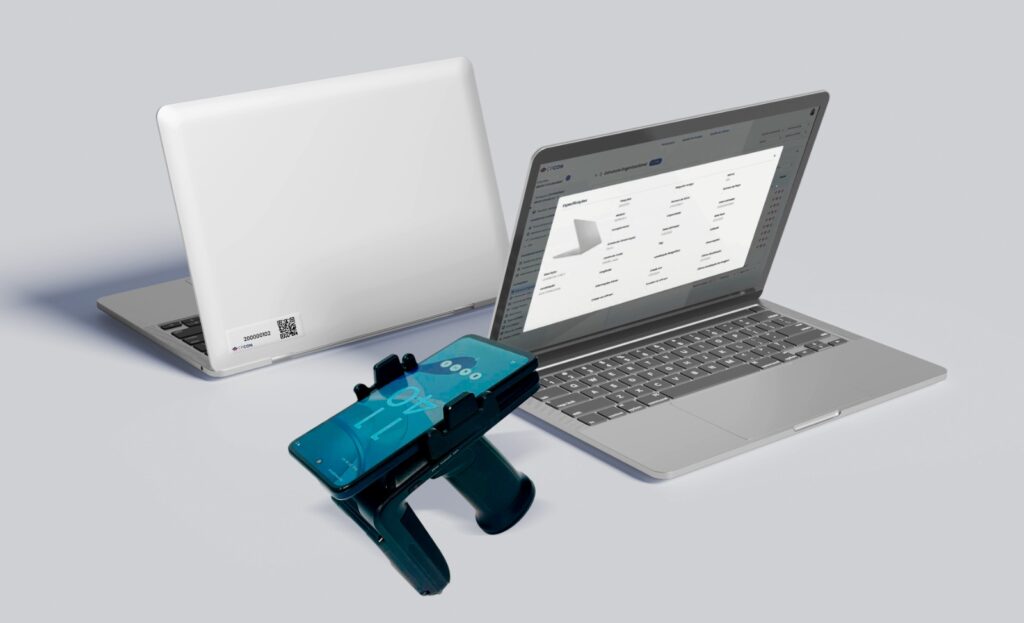Inventory management is one of the biggest challenges companies face today — especially when excess stock goes unnoticed until it’s too late. Poor visibility leads to overbuying, rising storage costs, and products that sit idle while capital is tied up and operations slow down.
RFID technology is transforming inventory management by bringing real-time tracking, automated control, and accurate data to every step of the supply chain. It helps businesses prevent overstocking, reduce operational waste, and make smarter purchasing decisions based on real consumption — not guesswork.
In this article, you’ll learn how RFID works, why it’s more effective than traditional inventory systems, and how it’s helping companies move from inventory chaos to complete control.

Table of Contents
ToggleWhat Is RFID Inventory Management and How Does It Work?
RFID inventory management is a modern, data-driven approach to tracking inventory in real time. Unlike traditional barcode systems, RFID doesn’t require line-of-sight or manual scanning. It uses radio waves to capture data from RFID tags attached to each item, allowing for instant visibility and greater control over inventory flow.
At its core, RFID inventory management is built on four key components:
- RFID Tags: Attached to each inventory item, these tags store a unique identifier — and, in some cases, detailed information like batch numbers or expiration dates.
- RFID Readers and Antennas: These devices communicate with the tags using radio frequency. They automatically detect nearby items without requiring direct contact or scanning.
- Inventory Management Software: The system receives and interprets the data in real time, updating inventory levels, locations, and movements automatically.
- Automation Layer: Based on pre-configured rules, the system can generate alerts, update reorder points, and track compliance.
This automated structure allows businesses to:
- Track inventory at every stage — from receiving to shipping
- Identify stock movement instantly across multiple locations
- Prevent stockouts and overstock situations
- Eliminate the need for manual counts or spreadsheet reconciliation
Unlike traditional systems that rely on periodic audits, RFID provides a continuous, real-time snapshot of your inventory. That means faster decisions, better forecasts, and fewer errors — all essential for effective inventory management in a fast-paced supply chain environment.
How Does RFID Compare to Traditional Barcode Inventory Management?
For decades, barcode systems have been the standard for tracking inventory in warehouses, stores, and distribution centers. But while barcodes still play a role in many U.S. operations, they’re increasingly being replaced — or at least supplemented — by RFID technology.
Here’s how the two systems compare in real-world inventory management:
1. Data Capture and Speed
- Barcode: Each item must be scanned individually, usually by hand. This slows down large-scale counts and leaves room for human error.
- RFID: Tags are read automatically, even without a clear line of sight. A single RFID reader can scan hundreds of items in seconds.
Think of it like self-checkout at a grocery store. Barcode systems require you to scan each item one by one. RFID works more like a sensor that detects everything in your cart as you walk through the gate.
2. Accuracy and Data Capacity
- Barcode: Stores basic information (like a SKU) and depends on system databases for context.
- RFID: Can hold detailed data directly on the tag — such as serial number, production date, or even temperature history — which is especially useful for pharmaceuticals, electronics, and food logistics.
According to a study by Auburn University’s RFID Lab, inventory accuracy with traditional systems typically hovers around 65%, while RFID can push that number above 95%.
3. Durability and Reliability
- Barcode: Labels can wear out, get scratched, or become unreadable — especially in cold storage, outdoor environments, or manufacturing floors.
- RFID: Tags are more resistant to moisture, dirt, and wear-and-tear. In industries like automotive or logistics, this translates to fewer failures in tracking.
4. Automation Potential
- Barcode: Manual scanning is still the norm, requiring labor and time.
- RFID: Supports full automation — items are tracked as they move in and out of storage areas, loading docks, or retail shelves. No manual steps needed.
5. Operational Efficiency
- Barcode: Works well for small or low-volume environments where inventory is handled one item at a time.
- RFID: Best suited for high-volume operations, multi-site networks, or any business looking for real-time inventory management.
Tackling Overstock Issues with RFID Inventory Management
Let’s be honest — excess inventory isn’t just an accounting problem. It’s a daily operational challenge that quietly eats away at your company’s cash flow, warehouse space, and ability to respond to demand. And in many U.S. businesses, especially mid-size distributors and retailers, it’s a sign that your inventory management system is lagging behind.
RFID technology changes that. It gives you the tools to stop overstock before it starts — by tracking what’s actually moving in your operation, in real time.
Here’s how RFID helps solve overstock problems in practice:
Real-Time Inventory Visibility
Instead of relying on weekly cycle counts or outdated spreadsheets, RFID gives you a live view of what’s in stock, where it is, and how it’s moving. As soon as an item enters or leaves a storage area, the system updates automatically — no manual input required.
This level of visibility is critical during peak sales seasons, product launches, or supplier delays. It helps prevent over-ordering and gives your team confidence in the numbers they’re seeing.
Reliable, Accurate Data
Manual entries and barcode scanning come with a risk of human error — especially when teams are under pressure. RFID minimizes that risk by automating the process and ensuring every item is accounted for with high precision.
A study by the RFID Lab at Auburn University found that retailers using RFID improved inventory accuracy to over 95%, compared to the 65–75% typically seen with barcodes
(RFID Journal).
That level of accuracy doesn’t just improve operations — it also reduces unnecessary purchases and holding costs.
Actionable Business Insights
RFID isn’t just a tracking tool. It’s a data generator.
By analyzing movement patterns, restocking cycles, and item-level sales behavior, RFID systems help businesses understand what’s actually driving overstock — and what they can do about it. You can spot slow-moving SKUs, adjust reorder points, or shift inventory between locations with much more confidence.
This kind of insight is especially valuable in U.S. retail and e-commerce, where demand can shift quickly due to seasons, promotions, or regional trends.
Cash Flow Relief
Every extra unit sitting in your warehouse represents money you can’t invest elsewhere — in product development, hiring, or marketing. RFID helps free up that working capital by keeping your inventory leaner, faster-moving, and more responsive to actual demand.
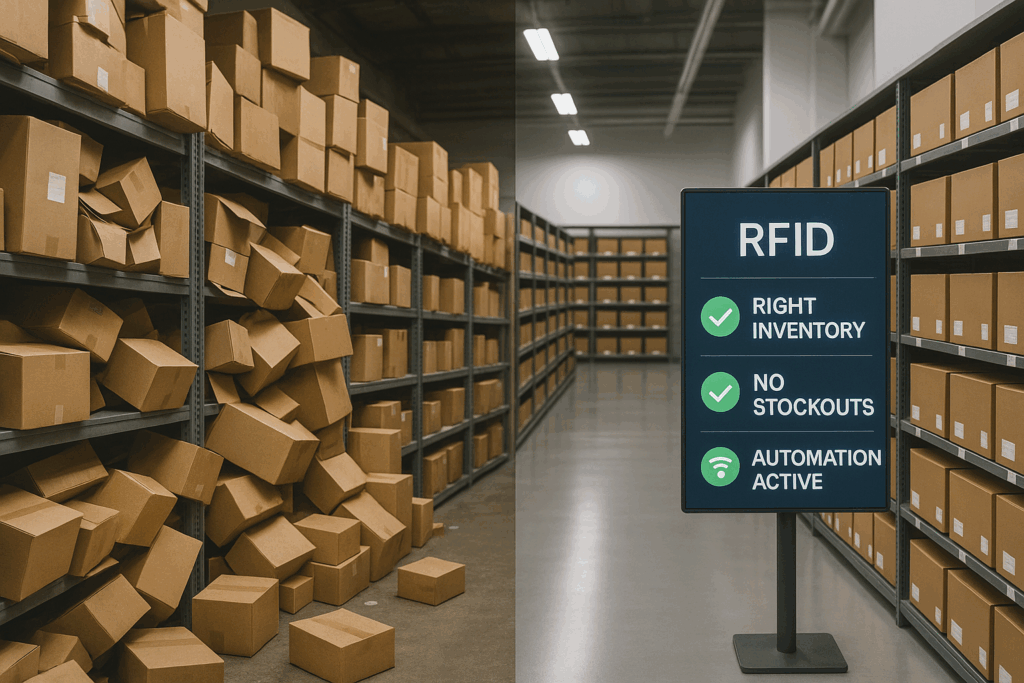
The Importance of RFID Inventory Management
In today’s fast-moving business environment, managing inventory isn’t just about keeping shelves stocked — it’s about making smarter, faster decisions that keep your operation efficient and your customers satisfied.
For companies across the U.S., RFID inventory management is becoming a key differentiator. It provides the accuracy, automation, and real-time visibility that traditional systems can’t deliver.
From Uncertainty to Real-Time Control
When inventory is managed manually — or even with barcode-only systems — gaps in visibility are inevitable. You may not know exactly how much stock you have, where it’s located, or whether it’s been properly tracked between warehouses, stores, or distribution points.
RFID solves that by automatically updating inventory counts the moment items move. Instead of waiting for a weekly cycle count, your system always knows what’s in stock — and what’s not.
This matters when you’re preparing for a sales spike, managing returns, or handling seasonal demand — common realities for U.S.-based retailers, distributors, and logistics providers.
Accurate Data, Without the Headaches
Manual data entry and barcode scanning are prone to human error, which can lead to costly stockouts, write-offs, and unreliable reports. But automation through RFID yields cleaner, more accurate data.
For example, a comprehensive joint study by Auburn University’s RFID Lab and GS1 US—known as “Project Zipper”—examined how brands and retailers tracked shipments and inventory. The results were striking: companies using RFID achieved nearly 99.9% order accuracy, compared to error rates of nearly 70% under legacy barcode systems.
A Smarter Supply Chain Starts Here
RFID doesn’t just help with what’s inside your warehouse — it helps you coordinate with your suppliers, forecast demand more precisely, and reduce unnecessary purchases.
In sectors like fashion, healthcare, electronics, or food service — where speed, traceability, and compliance are critical — RFID enables faster turnaround, fewer errors, and better control across every stage of the supply chain.
Turning Data into Strategy
Beyond the operational benefits, RFID helps leaders see the bigger picture.
By analyzing item movement, turnover rates, and shrinkage patterns, companies can optimize inventory levels, plan smarter promotions, and even redesign warehouse layouts. Instead of reacting to problems after they happen, teams are empowered to prevent them altogether.
What Are the Challenges in Transitioning to RFID Inventory Management?
RFID can revolutionize how companies handle inventory — but like any new technology, its implementation comes with challenges. Understanding these upfront is key to making the transition smooth and successful.
Here’s what U.S.-based businesses often face when moving from traditional systems to RFID:
1. Integration with Existing Systems
Most companies already use some kind of ERP, WMS, or POS system. One of the first challenges with RFID is making sure it connects with those platforms — and that the data flows correctly between them.
For example, a distributor in Ohio might use NetSuite or SAP to manage orders and inventory. Adding RFID means syncing real-time tag data with those systems to ensure accurate reporting. Without this integration, you end up with more silos — not fewer.
2. Technical Environment and Infrastructure
RFID relies on physical infrastructure: readers, antennas, tags, and software. But environmental factors like metal shelves, high humidity, or interference from machinery can affect how well the system reads each tag.
A warehouse storing liquids, electronics, or heavy equipment may need to test different RFID setups before getting consistent performance.
3. Staff Training and Process Change
Even the best technology fails without buy-in from the people using it. RFID often means changing how items are received, moved, or tracked — and that requires new habits.
Your warehouse team may be used to scanning barcodes. RFID removes the need for that — but employees still need to understand how it works, what’s automated, and when to intervene. Training is key.
4. Managing and Protecting Inventory Data
RFID systems generate a lot of data — in real time. That’s a huge advantage, but it also means companies need clear protocols for data management, reporting, and cybersecurity.
Whether you’re storing data on-premises or in the cloud, keeping that information secure (especially in regulated industries like healthcare or food) is essential.
5. Cost and ROI Uncertainty
RFID is more affordable than it was a decade ago, but it’s still an investment. Tags, hardware, software licenses, installation — it adds up. Some companies hesitate because they can’t immediately see the return.
That’s why starting with a focused use case — like tracking high-value items or automating a single warehouse process — can be smarter than a company-wide rollout from day one.
How Can Businesses Implement RFID Inventory Management Practices?
Implementing RFID doesn’t have to be overwhelming — and it shouldn’t be. The most successful RFID projects begin with a clear strategy, realistic goals, and a phased rollout that aligns with the company’s operations and priorities.
Here’s a practical step-by-step approach for businesses looking to integrate RFID into their inventory management process:
1. Assess Your Current Inventory Process
Start by identifying where your inventory blind spots and inefficiencies are. Do manual counts take too long? Are items frequently misplaced? Are certain SKUs consistently overstocked or out of stock?
Understanding your current weaknesses will help you define where RFID can deliver the most value — whether it’s accuracy, visibility, speed, or automation.
2. Define Clear Objectives
Set measurable goals for your RFID rollout. Are you trying to reduce inventory write-offs? Improve receiving accuracy? Eliminate manual cycle counts?
For example, a regional wholesaler might aim to reduce excess stock by 20% within six months by using RFID to track inbound shipments more precisely.
3. Choose the Right RFID Technology
There’s no one-size-fits-all solution. RFID systems vary depending on your environment, budget, and operational needs.
- Passive RFID is common in retail and warehouse settings.
- Active RFID is used when tracking high-value assets or longer ranges, like equipment in large yards or hospitals.
Work with a qualified RFID integrator or partner to select tags, readers, and software suited to your inventory volume and storage conditions.
4. Pilot Before You Scale
Rather than deploying RFID across your entire operation at once, start with a focused test — such as one product category, one warehouse zone, or one high-value process like returns or shipping.
This allows you to identify technical challenges, train staff, and measure ROI in a controlled environment before scaling.
5. Train Your Team
Even though RFID automates many steps, your team still plays a central role in success. Warehouse staff need to understand how tagging works, what each reader does, and how to respond to system alerts.
Training should go beyond technical know-how — it should reinforce how RFID improves their workflow, reduces manual errors, and makes day-to-day operations smoother.
6. Monitor, Adjust, and Expand
Once the system is live, monitor results closely. Are inventory levels more accurate? Are exceptions being flagged automatically? Has picking speed improved?
Use this feedback to fine-tune the setup, optimize reader placement, and adjust reporting rules. From there, you can expand the rollout to other categories, sites, or processes.

RFID Inventory Management for Circular Supply Chains and Sustainable Growth
Inventory management isn’t just about efficiency anymore — it’s also about responsibility. As U.S. companies face growing pressure to reduce waste, comply with ESG standards, and embrace more sustainable business practices, RFID is becoming a key enabler of circular supply chains.
Rather than treating products as linear assets that move from supplier to consumer to landfill, RFID makes it possible to track, reuse, and repurpose inventory at every stage of the product lifecycle.
Here’s how modern RFID solutions, like CPCON’s Inventory Tracking Platform, are helping businesses do just that:
1. RFID-Enabled Product Lifecycle Management
From the moment a product is manufactured, RFID tags allow companies to capture its full history — from materials used, to distribution paths, to customer returns. This visibility supports:
- Easier product recalls
- Component reuse in remanufacturing
- Accurate environmental impact reporting
For manufacturers and retailers looking to reduce waste or implement take-back programs, RFID makes closed-loop processes much easier to manage.
2. Intelligent Track and Trace for Sustainability Compliance
In industries like electronics, automotive, or industrial equipment, suppliers often need to prove environmental compliance. RFID-enabled tracking provides documented evidence of sourcing, use, and disposal — helping companies meet EPA regulations, LEED certifications, and customer expectations.
By integrating RFID into their supply chains, businesses gain the ability to verify where products came from, how they were handled, and whether they meet sustainability standards.
3. Centralized RFID Product Hub
Modern RFID inventory platforms serve as a centralized digital database for all tagged items — tracking not only location and movement, but also usage, repair history, and disposal dates.
This level of traceability helps operations teams:
- Identify which parts can be refurbished or reused
- Monitor product wear and schedule maintenance
- Report on circularity goals and ESG metrics
Instead of reactive waste management, companies can now proactively manage the full lifecycle of their inventory and assets.
Conclusion
RFID is no longer just about tracking — it’s about transforming how businesses manage inventory. From reducing overstock to automating warehouse operations, RFID gives companies the data, speed, and accuracy needed to scale with confidence.
If your current system relies on spreadsheets or barcode scans, it’s time to rethink how you manage your inventory.
How CPCON Supports RFID Inventory Management and Control
With over 25 years of experience in inventory and asset management, CPCON delivers end-to-end solutions to help companies implement RFID and optimize their inventory processes — from planning to execution.
Here’s what CPCON offers:
- RFID inventory tracking systems
- Fixed asset inventory and reconciliation
- Baseline inventory tagging and RFID labeling
- IT asset management and automation
- Integration with ERP and WMS platforms
- RFID portals and real-time tracking architecture
- Circular inventory management for sustainability and compliance
- Customized dashboards and business intelligence tools
- On-site assessments and pilot implementations
- Advisory on tax, audit, and regulatory compliance
Whether your company needs to eliminate excess inventory, gain real-time control over high-value items, or scale inventory operations across multiple locations, CPCON has the tools, software, and expertise to get it done efficiently.
Talk to our experts and discover how CPCON can help your company.
FAQ
What is RFID inventory management?
It’s a system that uses radio frequency technology to track inventory in real time — without manual scanning or line of sight. RFID helps businesses improve accuracy, reduce waste, and automate inventory processes.
How does RFID help prevent excess inventory?
By showing exactly what’s in stock, where it is, and how it moves, RFID helps companies avoid over-ordering and cut down on safety stock.
Is RFID better than barcodes for inventory control?
Yes. RFID can read multiple items at once, even at a distance. It automates the tracking process and provides more detailed data than traditional barcode systems.
What’s the ROI of switching to RFID?
Companies using RFID often see faster inventory counts, fewer errors, and better stock accuracy — which leads to reduced labor costs and better cash flow. ROI depends on the scope of implementation, but results are measurable.
Can small and mid-sized businesses use RFID?
Absolutely. Many U.S. mid-market companies use RFID in specific areas — like tracking high-value items or managing seasonal inventory — before scaling up as the benefits become clear.
Get to Know CPCON Group: A global expert in asset management and inventory solutions
CPCON Group is a global leader in asset management, fixed asset control, and RFID technology. With over 25 years of experience, we have supported major companies such as Nestlé, Pfizer, Scania, BASF, Coca-Cola Andina, Vale, Vivo, Petrobras, and Caixa in high-complexity projects.
Curious about our global footprint? We are present in:
- North America: Toronto, New York, Miami, Minneapolis, Seattle, Dallas
- Latin America: São Paulo, Buenos Aires, Lima, Bogotá, Mexico City
- Europe: Lisbon, Porto, London, Birmingham, Milan, Rome, Turin, Madrid, Bilbao
- Middle East: Dubai, Saudi Arabi
- Caribbean: Tortola, Grand Cayman
Follow our LinkedIn Showcase Page and stay updated with strategic content on asset control, inventory management, and RFID innovation across industries.
This article explains how RFID inventory management helps businesses in the U.S. gain real-time visibility, reduce excess stock, and improve inventory accuracy. It covers how RFID works, its advantages over barcodes, and how companies can implement it gradually. The content also explores its role in circular supply chains and sustainability, offering practical guidance for retail, logistics, and manufacturing operations. Sources include studies from Auburn University, GS1 US, and Deloitte.

